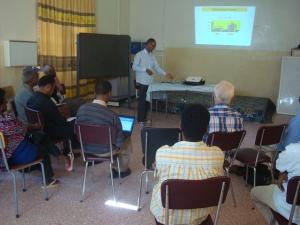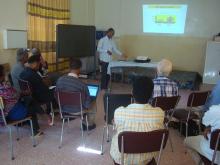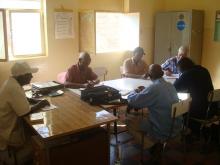Eritrea conducted Mid-Term review of Health Sector Strategic Development Plan (HSSDP)
Based on the National Health Policy, the MOH developed the Health Sector Strategic Development Plan (HSSDP 2012-2016). It provides the guidance and priorities to move from policy to action and sets the overall objectives, strategies, outputs and targets that are to be attained. The HSSDP is implemented through Annual Operational Plans, specific for each level of service provision. It has been over two and half years since the HSSDP has been implemented.
Upon the request of the MOH, a team of independent international experts from WHO and national experts undertook the Mid Term Review of the HSSDP over three weeks in November 2014. This review was carried out with the stewardship of the Minister of Health, Her Excellency, Ms Amina Nurhussien.
The review team - visited 4 of the 6 Zobas and went to all levels of the health care system, they interviewed staff from all major Departments, Divisions and Units of the MOH, reviewed available documents and had regular debriefing meetings with the national Steering Committee that provided oversight to the reviewers work. They also had the chance to interview other stakeholders in the sector, such as UN Agencies, government departments and the umbrella organization of the Faith-Based Organizations. The conduct of a first review of such an important strategic document is always a challenging exercise. It shows vision and courage to have it done.
At the end of the mission, the MOH organized a debriefing meeting in which all stakeholders participated. Among others present in this debriefing meeting were Her Honorable Minister of Health, WHO Representative and his team, Members of the Steering Committee, Advisors to the Minister, Director Generals, Directors, Zonal Medical Officers and program managers. The findings of the review spelled out the achievements gained, challenges faced and key recommendations to be implemented within the current HSSDP and during the roll out of the next HSSDP. During the debriefing, both Her Honorable Minister and the WHO Representative, Dr Abdulmumini Usman acknowledged and appreciated the scope and depth of the technical support provided for the review by the experts.
The Mid Term Review highlighted that Eritrea has achieved many outstanding successes. It will likely achieve its targets for the three health related MDGs: by reducing its IMR from 72/1000 in 1995 to 42/1000 in 2010; reducing its Maternal Mortality from 998/100,000 in 1995 (DHS) to 486/100,000 in 2010 (EPHS); and reducing the prevalence of HIVAIDS from 2.47% in 2003 to 0.79% in 2011; bringing TB incidence and prevalence down to respectively 97/100,000 and 151/100,000 and TB mortality from 12/100,000 in 1990 to 4.7/100,000 in 2011. Malaria incidence has declined from 53 cases /100,000 in 1998 to 4.78 cases/100,000 in 2014, thus allowing the country to embark on the pre-elimination phase. There are also successes in other areas of service provision, like reduction of Female Genital Mutilation and EPI coverage for Penta and Measles, consistently more than 90%. Also in the area of hygiene and sanitation successes are reported with already 18% of the 2,666 rural villages in the country having been declared "Open Defecation Free". In the area of Health Systems Strengthening (HSS) the number of 'home-trained' doctors and nurses is increasing, slowly filling the gaps from the increase in infrastructure and the relatively modest attrition, the provision of drugs and consumables appear regular with relatively few incidences of 'out-of-stock' of essential drugs. Laboratory services exist in all regional hospitals, in 20 other hospitals and in 43 community hospitals/health centers. The National Blood Transfusion Services produce some 10,000 blood units per year, all from volunteers.
The establishment of a Policy and Planning division has added value to the planning in the sector. Guidelines have made planning and monitoring a regular feature at Zoba and Sub-zoba levels, with the development of annual action plans and quarterly monitoring sessions. Commitment at all levels is high. Health Management Information Systems (HMIS) shows timely routine data reporting (90%) and completeness (98%). There is a comprehensive M&E framework for 2012-2016, linked with the HSSDP, providing targets. MOH has a Research Agenda in place and some research applications have been submitted.
Financing the HSSDP shows some positive developments, like the introduction of modest cost recovery and limited private practice in the hospitals (with exemption mechanisms in place). There are signs of improved availability of funds and the annual (upfront) funding of the health sector by the MOF improves predictability. Given the low resource base in which the health sector operates its achievements in terms of improved health of its population are outstanding and a shining example for many countries on the continent.
These many achievements do not imply that there are no challenges to address. The main recommendations from this MTR are summarized also in the report. The findings of the MTR do not suggest the need for revising the current HSSDP. The short-term suggestions are meant for the enhancement of the implementation of the current HSSDP.
Based on the National Health Policy, the MOH developed the Health Sector Strategic Development Plan (HSSDP 2012-2016). It provides the guidance and priorities to move from policy to action and sets the overall objectives, strategies, outputs and targets that are to be attained. The HSSDP is implemented through Annual Operational Plans, specific for each level of service provision. It has been over two and half years since the HSSDP has been implemented.
Upon the request of the MOH, a team of independent international experts from WHO and national experts undertook the Mid Term Review of the HSSDP over three weeks in November 2014. This review was carried out with the stewardship of the Minister of Health, Her Excellency, Ms Amina Nurhussien.
The review team - visited 4 of the 6 Zobas and went to all levels of the health care system, they interviewed staff from all major Departments, Divisions and Units of the MOH, reviewed available documents and had regular debriefing meetings with the national Steering Committee that provided oversight to the reviewers work. They also had the chance to interview other stakeholders in the sector, such as UN Agencies, government departments and the umbrella organization of the Faith-Based Organizations. The conduct of a first review of such an important strategic document is always a challenging exercise. It shows vision and courage to have it done.
At the end of the mission, the MOH organized a debriefing meeting in which all stakeholders participated. Among others present in this debriefing meeting were Her Honorable Minister of Health, WHO Representative and his team, Members of the Steering Committee, Advisors to the Minister, Director Generals, Directors, Zonal Medical Officers and program managers. The findings of the review spelled out the achievements gained, challenges faced and key recommendations to be implemented within the current HSSDP and during the roll out of the next HSSDP. During the debriefing, both Her Honorable Minister and the WHO Representative, Dr Abdulmumini Usman acknowledged and appreciated the scope and depth of the technical support provided for the review by the experts.
The Mid Term Review highlighted that Eritrea has achieved many outstanding successes. It will likely achieve its targets for the three health related MDGs: by reducing its IMR from 72/1000 in 1995 to 42/1000 in 2010; reducing its Maternal Mortality from 998/100,000 in 1995 (DHS) to 486/100,000 in 2010 (EPHS); and reducing the prevalence of HIVAIDS from 2.47% in 2003 to 0.79% in 2011; bringing TB incidence and prevalence down to respectively 97/100,000 and 151/100,000 and TB mortality from 12/100,000 in 1990 to 4.7/100,000 in 2011. Malaria incidence has declined from 53 cases /100,000 in 1998 to 4.78 cases/100,000 in 2014, thus allowing the country to embark on the pre-elimination phase. There are also successes in other areas of service provision, like reduction of Female Genital Mutilation and EPI coverage for Penta and Measles, consistently more than 90%. Also in the area of hygiene and sanitation successes are reported with already 18% of the 2,666 rural villages in the country having been declared "Open Defecation Free". In the area of Health Systems Strengthening (HSS) the number of 'home-trained' doctors and nurses is increasing, slowly filling the gaps from the increase in infrastructure and the relatively modest attrition, the provision of drugs and consumables appear regular with relatively few incidences of 'out-of-stock' of essential drugs. Laboratory services exist in all regional hospitals, in 20 other hospitals and in 43 community hospitals/health centers. The National Blood Transfusion Services produce some 10,000 blood units per year, all from volunteers.
The establishment of a Policy and Planning division has added value to the planning in the sector. Guidelines have made planning and monitoring a regular feature at Zoba and Sub-zoba levels, with the development of annual action plans and quarterly monitoring sessions. Commitment at all levels is high. Health Management Information Systems (HMIS) shows timely routine data reporting (90%) and completeness (98%). There is a comprehensive M&E framework for 2012-2016, linked with the HSSDP, providing targets. MOH has a Research Agenda in place and some research applications have been submitted.
Financing the HSSDP shows some positive developments, like the introduction of modest cost recovery and limited private practice in the hospitals (with exemption mechanisms in place). There are signs of improved availability of funds and the annual (upfront) funding of the health sector by the MOF improves predictability. Given the low resource base in which the health sector operates its achievements in terms of improved health of its population are outstanding and a shining example for many countries on the continent.
These many achievements do not imply that there are no challenges to address. The main recommendations from this MTR are summarized also in the report. The findings of the MTR do not suggest the need for revising the current HSSDP. The short-term suggestions are meant for the enhancement of the implementation of the current HSSDP.
________________________________________________
Below:
01. One of the presentations in progress.
02. Participants of the MTR.





